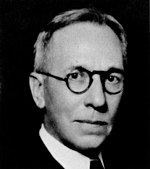Prevost Hubbard

There were many professional men who made major contributions to the development of America’s roads. One such man was a scientist named Prevost Hubbard. Between 1905 and 1919 he developed for the Office of Public Roads methods for testing and specifying bituminous pavement materials which eventually became standards of the highway construction industry and the foundation of modern materials technology.
Hubbard, born in 1881, was educated at George Washington University in Washington, D.C. He joined OPR in 1905 as the agency’s first laboratory chemist to help sort out and develop standards for the wide variety of petroleum based products then being experimented with as surfacing agents for highways.
He became active in the American Society for Testing Materials and spearheaded, with Logan Waller Page, Committee H (now Committee D-4 on Road and Paving Materials). He served as secretary of the Committee from 1909 to 1946.
In 1919 Hubbard joined the Asphalt Institute, first known as the Asphalt Association, to direct a research and development program sponsored by the petroleum industry. The Institute’s laboratory had its beginning in the basement of Hubbard’s home in White Plains, New York. One of the first accomplishments under his leadership was the development of Medium Curing Cutback Asphalt, a liquid form of asphalt, later used extensively in the construction of low-cost, low-volume, all-weather pavements.
During the early 1920’s an intensive effort was made to reduce the number of specifications in effect in the United States. The asphalt industry, under the direction of Hubbard, in cooperation with the States and Bureau of Public Roads, was successful in reducing the grades of asphalt cement in use from 88 to 9 and asphalt joint sealers from 14 to 4. Similarly, Hubbard’s cooperative efforts during the 1930’s led to the successful reduction of the number of grades of liquid asphalts used by 33 States from 125 to 18.
The latter study included an extensive testing program of most liquid asphalts produced in the United States. J. T. Pauls of the Bureau of Public Roads commented on the study in a progress report in 1932:
Representatives of the Bureau of Public Roads and Mr. Hubbard of the Asphalt [Institute] stressed the fact that they believed in the adequacy of the proposed cooperative tests for the testing of liquid asphaltic products and felt that many tests now being used by the States were unnecessary and unsatisfactory.
Hubbard went on to develop methods for testing the design of paving mixtures. With the assistance of F. C. Field of the Asphalt Institute, Hubbard invented the Hubbard-Field Stability Test, which became the first widely accepted test to measure the strength of asphalt paving mixtures.
He died in 1971 at the age of 90. A year later Committee D-4 on Road and Paving Materials established the “Prevost Hubbard Award” in recognition of his outstanding service to the Committee and to the field of bituminous road and paving materials.
322
